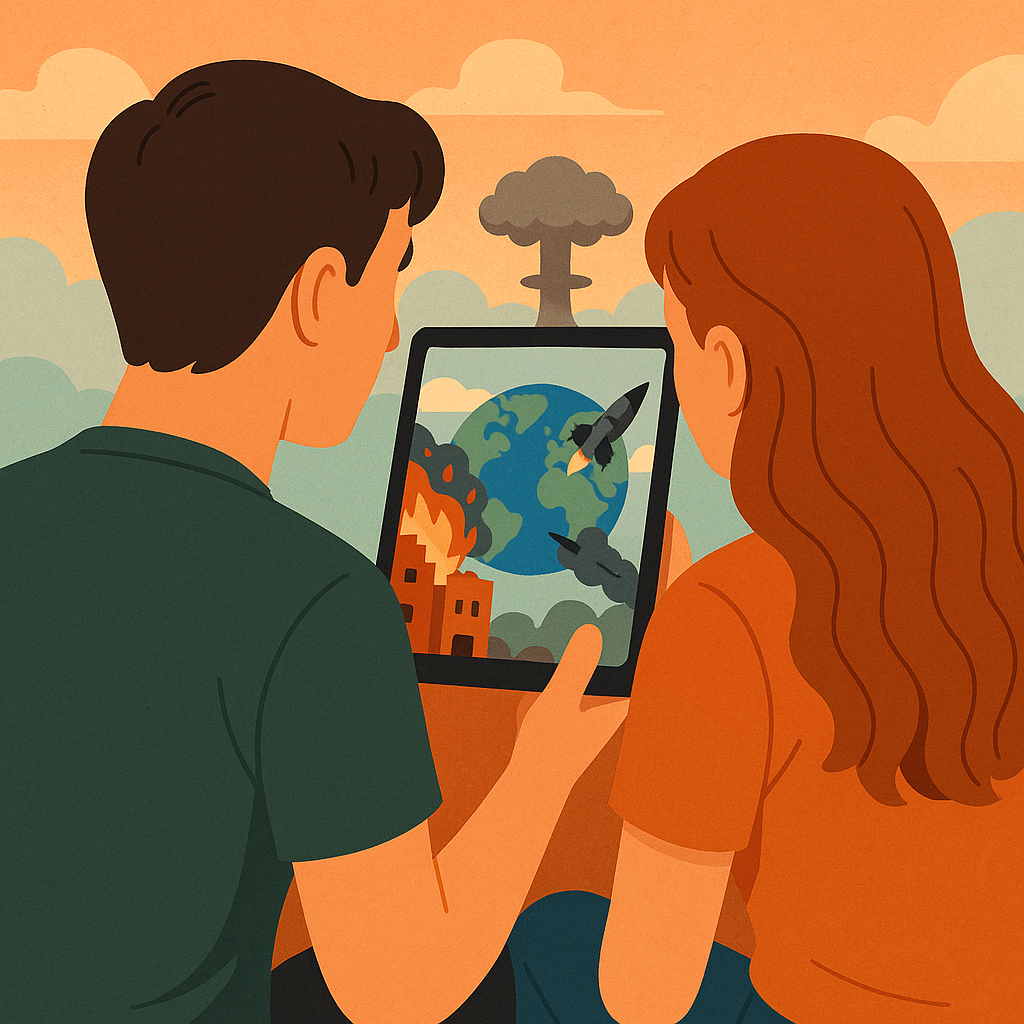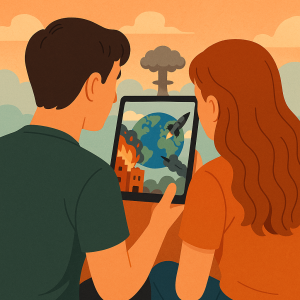Amid the current tensions between Iran and Israel, and with the Pahlavi dynasty’s exiled heir re-entering the spotlight, it’s worth revisiting what Iran was like before Ayatollah Khamenei’s rule.
In the decades preceding the 1979 revolution, Iran under Shah Mohammad Reza Pahlavi presented a facade of sweeping progress. Infrastructure, culture, and education seemed to flourish—but beneath the glitter lay social unrest, inequality, and oppression.
From British Roots to Oil Boom
The Pahlavi dynasty itself was a product of geopolitical maneuvering: following the 1921 British-backed coup, Reza Shah replaced the Qajar dynasty, planting the seeds for a modernizing authoritarian regime.

Shah meeting with U.S. president Franklin D. Roosevelt during the Tehran Conference (1943), two years after his father’s forced abdication during the Anglo-Soviet invasion of Iran. U.S. Library of Congress. Public domain via Wikipedia commons
Reza Shah’s efforts to balance British and Soviet influence by fostering ties with Nazi Germany alarmed the Allies during World War II. In August 1941, the United Kingdom and the Soviet Union jointly invaded the officially neutral Imperial State of Iran during World War II, carried out by British, Commonwealth, and Soviet forces. The invasion, codenamed Operation Countenance, took place from August 25 to September 17, 1941, became known as the Anglo-Soviet invasion. Its goals were to secure Iranian oil fields and establish reliable Allied supply lines to the Soviet Union through the Persian Corridor, a crucial logistical route on the Eastern Front.
Although Iran declared neutrality, Reza Shah was forced to abdicate shortly after, and his son, Mohammad Reza Pahlavi, ascended the throne as British and Soviet forces occupied the country until 1946.
The oil industry, nationalized in the early 1950s under democratically elected Prime Minister Mohammad Mossadegh, became a flashpoint. Mossadegh’s position became precarious after the election of President Eisenhower. While Mossadegh’s 1953 bid to wrest control from British interests earned him hero status among Iranians, his overthrow—via CIA-backed Operation Ajax—demonstrated that U.S. Cold War fears and paranoia outweighed respect for democracy.

Photograph of President Truman and Prime Minister Mohammad Mossadegh of Iran. Public domain via Wikipedia commons. http://narademo.umiacs.umd.edu/cgi-bin/isadg/viewobject.pl?object=20420
The Shah was swiftly reinstated as an absolute monarch, with U.S. assistance, who then expanded SAVAK, his brutal secret police, while Western oil companies reclaimed their favored positions. The coup would leave a deep scar in Iranian political memory, fueling anti-Western resentment that would later culminate in the 1979 Islamic Revolution.

Anglo-Persian Oil Company workers. http://www.iichs.org/srcfiles/printmag.asp?id=180. Public domain via Wikipedia commons
White Revolution: Modernization with a Steel Fist
Before the Pahlavi dynasty, Iran’s society was deeply rooted in Islamic traditions, with the clergy holding strong influence over law and education. Early Pahlavi regimes, initiated a forceful push toward secularization and modernization, closing religious schools and limiting clerical authority. The early Shah’s aggressive push toward secularization—most notably the forced removal of the hijab and strict bans on traditional Islamic dress—alienated religious communities and many conservative Iranians saw these measures as attacks on their identity and values.

Shah Mohammad Reza Pahlavi speaks to people about principles of White Revolution. Catherine Legrand, Jacques Legrand: Shah-i Iran. Creative Publishing International (farsi edition), Minnetonka, MN 1999, S. 94. IR/RR. Public domain via Wikipedia commons
In 1963, Mohammad Reza Shah launched the White Revolution, a series of reforms intended to fast‑track modernization and westernization: land redistribution, infrastructure investments, literacy campaigns, and—for the first time—women’s suffrage. The Family Protection Laws of 1967 and 1973 strengthened rights in divorce, custody, and marriage, while universities expanded rapidly.

A Market in Tehran – 1970. http://salijoon.us/mail93/930208/ghadim/s9b8d.jpg. Public domain via Wikipedia commons
Yet these reforms were not democratic. A land transfer that enriched some rural workers also alienated traditional landlords—and empowered clerics. Public religious activism was strictly suppressed by SAVAK, which targeted Islamic activists and religious political groups. The regime responded to growing unrest and opposition with harsh repression: political opponents, including the National Front, leftists like the Tudeh Party, and religious leaders, faced censorship, harassment, imprisonment, and torture at the hands of the Shah’s ruthless secret police. Press was muzzled, opposition parties banned, and even intellectuals found themselves silenced.
The clergy, sidelined by the regime’s policies, began organizing grassroots resistance, channeling widespread anger and frustration into political opposition. Exiled since 1963, figures like Ayatollah Khomeini became powerful symbols of defiance, smuggling speeches and writings back into Iran that inspired growing protest movements.

Ayatollah Khomeini holds a press conference on Feb. 5, 1979 in Tehran, Iran. (AP Photo)
This mounting tension set the stage for a revolution fueled not only by political repression, but also by deep social and cultural grievances.
Glitter and Greed
Riding an oil-fueled economic boom, urban centers like Tehran began to rival Western capitals—with nightclubs, malls, and rapid industrial growth. But the wealth was uneven: rural regions still lacked clinics and schools, while corruption pervaded the royal court. By the mid-1970s, allegations of billion-dollar embezzlement within the Pahlavi inner circle had become public knowledge.

Removal of a statue of the Shah in Tehran University during the revolution in 1978. Public domain via Wikipedia commons. iichs.org
Inflation surged, and by 1978 the economy was faltering. Workers and students—especially in urban areas—became vocal in protests and strikes. Martial law was declared on September 8, 1978. The following day, security forces opened fire on protesters in Tehran’s Jaleh Square—a tragedy known as Black Friday.
Religion and youth became intertwined as catalysts. Khomeini’s messages, circulated secretly while in exile in Iraq and France, galvanized a dizzying spectrum: leftists, liberals, clerics, students, and women.

This picture was frontpaged by Iranian newspaper Kayhan, Thursday, February 22, 1979, and caption stated it was taken in Jaleh square, Tehran, September 8, 1978. http://cgi.wn.com/?action=display&article=82714495&template=worldnews/paidnews.txt&index=recent. Public domain via Wikipedia commons
Revolutionary Tipping Point
In January 1979, the Shah fled on a “vacation,” and by February crowds were chanting “Khomeini!”. The final rupture came in April, when a referendum saw 98% (contested number) of Iranians voting to abolish the monarchy and establish the Islamic Republic.

Ayatollah Khomeini returns to Iran after 14 years exile on February 1, 1979. He is helped off the plane by one of the Air France pilots.
sajed.ir. It has released under GFDL license. “باز نشر کلیه مطالب این سایت شامل مقالات، اخبار، صوت و تصویر و … به طور کامل و یا چکیده آن با ذکر منبع بلامانع است. Wikipedia Commons
Within months, secular statutes were reversed: the Family Protection Law dismantled, hijab made mandatory, gender segregation and morality policing enforced. Khomeini’s mantra—“Neither East nor West”—ushered in a deeply anti‑Western regime. When he died in 1989, Ayatollah Khamenei took over, steering Iran into a more religious and authoritarian future.
Authoritarianism in Limousine Shades
In hindsight, the Shah’s Iran appears as a study in contradictions: grandiose modernization and female empowerment wrapped in authoritarian cruelty and inequality. Luxurious palaces and Olympic-size oil revenues masked SAVAK’s torture chambers, rural neglect, and corruption of the elite.
His liberal veneer challenged religious conservatives—but the oppressive framework that underpinned it ensured that true democracy never blossomed. The White Revolution’s top‑down reforms failed to create enduring institutions of civic trust or political freedom. Instead, they stoked the very social and religious forces that would topple him.

Ruhollah Khomeini and people. Public domain via Wikipedia commons
Thus, the revolution of 1979—the most consequential geopolitical event in modern history—was less a spontaneous uprising and more an eruption over decades of repression. That roughly 11% participation, historically high compared to France or Russia ( 7-9%), reflected deep dissatisfaction with authoritarian modernism rather than religious zeal.
A Lasting Paradox

A banner shows pictures of Iraq’s top Shi’ite cleric, Grand Ayatollah Ali al-Sistani and Iran’s Supreme Leader Ayatollah Ali Khamenei at a rally to show solidarity with Iran, amid the Iran-Israel conflict, in the Shi’ite district of Kadhimiya, Baghdad, Iraq, June 21, 2025. REUTERS/Ahmed Saad
Amid renewed unrest, Reza Pahlavi—the exiled crown prince and grandson of the former Shah—has re-entered the spotlight, publicly stating on social media that he is prepared to return to Iran if called upon. “May I be with you soon.” — Reza Pahlavi (@PahlaviReza) on X.
Echoing former U.S. President Donald Trump’s slogan, he declared his intent to “make Iran great again,”.
Sources inside Iran say that the regime’s command and control structures are collapsing at a rapid pace. Meanwhile, the international community is beginning to realize that the Islamic Republic has no future. Our discussions about a post-Islamic Republic Iran have begun. https://t.co/86bJPP5bSi
— Reza Pahlavi (@PahlaviReza) June 19, 2025
As soon as the current regime is gone, we will rebuild Iran and we will Make Iran Great Again.@PahlaviReza pic.twitter.com/sfcKaX1QMF
— Reza Pahlavi Communications (@PahlaviComms) June 22, 2025








